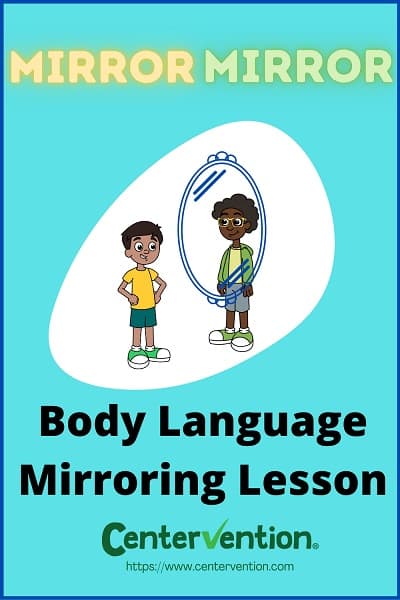We’ve created this fun two-step lesson that helps students to communicate with each other through body language mirroring and word games. These activities not only boost social skills, but also nurture empathy through mirroring, giving students a chance to appreciate each other and recognize that sometimes we’re not copying– we just enjoy the same things.
Students often get frustrated when a peer copies their speech or actions. But being inspired by others is naturally human, and it reflects admiration and curiosity. In fact, in early childhood “copying,” or parallel play, is a key stage of development as children play side-by-side mirroring each other’s actions. This builds confidence by allowing children to test the waters of something deemed “safe” by peers, and gives them perspective as they engage in others’ experiences through parallel tasks.
Ironically, trying on someone else’s shoes is actually what helps us solidify our own unique identity — we understand more about who we are and who we are not. Dr. Charles Whitehead describes, “Human childhood, a sheltered period of ‘extended irresponsibility’,allows us to develop our powers of make-believe and role-play, prerequisites for human cooperation, culture, and reflective consciousness.” Dr. Whitehead’s research into social mirroring explores the relationship between mirroring and self-awareness, communication, and cooperation. He adds, “Experiential empathy determines much of our waking behaviour.”
Mirroring doesn’t drop off after early childhood, it simply hits pause. While older students may not appreciate a perceived “copycat,” later and into adulthood, mirroring is again practiced as a form of social empathy, particularly when subtly captured with body language. In synchrony, we nod sympathetically, smile with shared enthusiasm, or lean in collectively. “Mirroring and synchronization of non-verbal behavior is an important characteristic of human conduct also in communication,” says Dr. Costanza Navarretta. Mirroring shows we are in tune and listening. Mirroring builds trust.
So what happens in the space between parallel play and adulthood, when students are frustrated at the idea of being copied? Somewhere down the line, communication through mirroring has stopped. While individuality and identity are developing, it can be hard for students to escape the ego and value compliment of imitation. Making space for activities that support cooperation skills in the classroom goes a long way in helping students tune into the collective community with empathy, and grow as compassionate communicators.
Recommended Grade Level: Elementary and Middle
SEL Skill(s): Communication, Empathy
Duration: 30 minutes
Materials:
- Favorite Things List (Available when logged into your Centervention educator account)
Body Language Mirroring Activity Instructions
Activity One
Gather students in a circle and tell them that they will be playing a game to practice cooperation and communication.
Say: “For the first part of this game you will watch me and pretend you are a mirror. Whatever movement I do, you should do too, just like a mirror. Pay attention as I change what I am doing so that you can follow along.”
Perform several pantomime motions such as pretending to brush your teeth and hair, straightening out your shirt sleeves, etc. Next, comment on what you noticed the students did well.
Ask: “What was challenging for you?”
Tell the students they will now get to take turns with a partner playing the mirror game.
Say: “First, decide who will go first, and I will set a timer for 20 seconds. The first person should pretend to do something and the second person should try and mimic their actions.”
Play two rounds of the partner mirror game allowing students to take turns.
Ask: “How did it feel trying to follow along with a friend and understand their movements?”
Activity Two
Say: “Now we’re going to change it up a bit. Turn and face your partner. I’m going to ask a question. Think about the answer in your head. I’ll say 1, 2, 3 and right after I say 3, both partners should say their answer out loud at the same time, and it’s okay if your answers are different. Once your answers are revealed you and your partner will take turns listening to each other explain why you chose the answer.”
Model the process with a student, telling the student they will explain first.
Say: “Okay, favorite book… 1, 2, 3, (answer together). Why is that your favorite book?”
(Allow the student to answer)
Say: “Now ask me why I chose my book.”
(Allow them to ask and then you answer)
Say: “It’s fun to cooperate and say it at the same time, but it’s also fun to listen more and learn about each other!”
Begin reading questions from the Favorite Things list and prompting with 1, 2, 3. Have students take turns explaining their answers. Play several rounds of the game, allowing partners to practice speaking, listening, and learning.
Say: “It can be exciting when friends say something at the same time, but challenging to wait your turn to speak again and share more. Being a good friend means taking turns talking and listening to each other. When we work together in communicating, we are able to have the most fun.”
